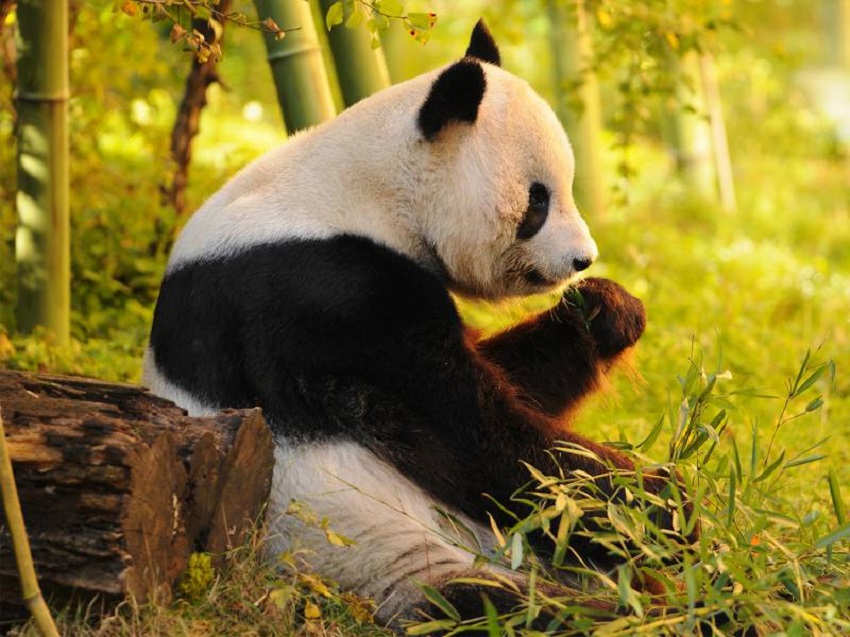The panda bear is known as the giant panda. It is an omnivorous mammal characterized by its black and white coloration and its fondness for bamboo. The giant panda inhabits Central China and Tibet’s remote mountainous regions at elevations of 1,200-4,100 meters above sea level. Before, its geographic range covered vast areas, including most of southern and eastern China. Today, it is only present in parts of 6 isolated mountain ranges: Minshan, Qinling, Qionglai, Liangshan, Daxiangling, Xiaoxiangling.
How do Pandas get to Know Their Wild Side?
The panda has limbs, ears, back and double loop around the eyes colored black, while the rest of his body is white. Scientists do not yet know exactly why this curious pattern of coloration. They suggest that it is useful for camouflaging itself among the snow and rocks of its natural habitat. Also, the dense coat allows it to stay warm.
Although it appears larger, the panda is around 1.2-1.9 meters in length and weighs between 100 and 115 kilos. Its front legs are stronger and more muscular than the back, as they are used for climbing. It has a characteristic known as the sixth finger used as a thumb, although it is a modification in their wrist’s bone.
Panda bear behavior
The panda bear is a lonely animal. It is most active during sunsets and tends to mark its territory with urine, odors, and claw marks; thus, they avoid confrontations.
Unlike other bears, the giant panda does not hibernate. It does descend to lower elevations during the cold winter in search of higher temperatures. At that time, it looks for caves, hollow trees, and crevices where it can keep warm.
Panda bear feeding
The panda is almost only herbivorous since 99% of its diet is made up of bamboo, and it can spend 10 to 12 hours a day feeding. It differs from other bears by having the ability to feed sitting. With its so-called sixth finger, it easily breaks bamboo.
On some occasions, it supplements its diet with birds, insects, eggs, and small rodents since bamboo cannot provide enough nutrients about its size and weight.
Playing of the panda bear
Both sexes reach sexual maturity between 5 and 7 years of age, although some individuals do so at 4 or as late as 8 years. Their sense of smell is widely used during the breeding season. Males can compete for the right to mate.
The copulation time is very short: it varies from 30 seconds to 5 minutes, but you can repeat it several times to achieve fertilization. The gestation period lasts approximately 5 months, after which the female gives birth to 1 to 2 blind pups weighing just 140 grams. They are born completely white, and as they grow, they acquire their particular coloration.
The giant panda is an insatiable bamboo eater. An average specimen spends half the day eating – literally: 12 out of 24 hours – and relieves itself dozens of times a day. It takes 12.5 kilos of bamboo to meet a giant panda’s daily dietary needs. It eagerly plucks the stems with its elongated wrist bones, using them as thumbs. They also occasionally eat birds or rodents.
Pandas are only found in the wild in remote mountainous regions of central China. The tall bamboo plantations there are cool and damp, just the way they like it. In summer, they can ascend to 4,000 meters of altitude to find their food on the highest slopes.
It is common to see panda bears eating relaxed while sitting on the ground, with their hind legs stretched forward. Although they appear to be sedentary, they climb trees with great skill and are excellent swimmers.
Giant pandas are solitary animals
They have a highly developed sense of smell, which males use to avoid each other and find a female to mate within spring. After a five-month pregnancy, the female gives birth to a single cub or twins, although she cannot care for both. The little ones weigh just 150 grams at birth and cannot crawl until they are three months old. They are born blind and white; only later does his hair take on the shades that make it so attractive.
Only about 1,000 giant pandas remain in the wild, and perhaps another 100 live in zoos, where it is always one of the most popular attractions. Much of what we know about pandas comes from observing them in captivity, as their cousins in the Chinese mountains are elusive and rare to see.
Panda bear extinction
Around 1,600 individuals are the alarming number of giant pandas that exist in their natural habitat. A few others live in zoos and are one of the biggest attractions in those places. The massive destruction of its habitat and uncontrolled hunting are the main reasons.
Currently, the Chinese government severely punishes actions against this species. This does not mean that it is out of danger of disappearing. According to the Red List of the International Union for Conservation of Nature, the giant panda is endangered. The protection of bamboo forests is one of the most important actions that contribute to their conservation.
Origin and evolution of the panda bear
From the genetic point of view, the origin of the panda bear is still not very clear. Until a few years ago, the giant panda was classified as a member of the all urine subfamily due to certain morphological features developed from their eating habits.
However, recent studies have shown that the panda is precisely a bear and that the similarities it presents with the red panda (ailuridae subfamily) result from sharing an environment. They had to look for mechanisms that led them to share similar traits.
Similarly, it is appropriate to clarify that the panda and the red bear have a common ancestor. It allowed the evolution of the ursids and the procyonids from evolutions conditioned by different latitudes.
Pandas never cease to amaze scientists. They have adapted to survive to this day and two because new specimens break with the black and white coat scheme to show off the combination of white, reddish, and brown.
As has been explained, this becomes a return to the panda’s features from the Pleistocene period. It later had to adapt its colors to black and white as a way of camouflaging itself in the glaciers.
Physical features
Pandas are identified by their white (medium yellowish) fur with black spots and a plump body. Traits that become survival mechanisms because they help him camouflage himself and scare enemies.
A giant panda usually measures up to 95 cm at the height at the withers and 1.5 m in body, including the head. The tail measures 13 cm, while its weight is usually 160 kg.
This mammal face is one of the features that most differentiates it from the rest of the bears. And it is that this is usually flattering and with a smaller snout, similar to cats. Similarly, their jaws are similar to those of herbivores, which is related to their eating habits.
For its part, pandas’ hair is not long, but it is thick, woolly, and abundant enough to protect it from the cold. The color of the coat is white, although as the bear ages, it turns yellowish. The black color is seen in the eyes, ears, legs, nose, feet, and in the stripes that surround the shoulders.
Due to its adaptations for eating bamboo, the panda has a bone extending from the wrist that some identify as the panda’s thumb or sixth finger, although it is not a finger.
The ears of this bear are round and large; the nose allows this animal to have a well-developed sense of smell and identify its predators and the like.
Habitat
In its last refuge in central China, the panda occupies mountainous forest areas. Its camping area is located in the high mountains, where crops do not reach. It is usually found above 1,500 m of altitude, approaching 4,000 m, although in winter, the intense snowfalls make it descend to 1,000 m, maybe even a little lower. It lives in cold and humid forests, generally of pines or other conifers. Above all, with abundant undergrowth of bamboo, its nutritious plant.
For this reason, the panda has had to raise the altitude of its habitat above that level. Between 1,500 and 2,000 m, there are remains of the old subtropical forest or secondary forests of various types of trees in some areas.

